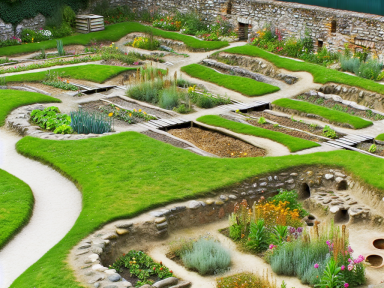Historical Methods to Maximize Water Retention in Gardens
From ancient civilizations to early modern gardeners, various techniques have been employed to retain water and conserve resources in garden soil. Here’s a deep dive into some time-tested methods that can still be incredibly effective today._
1. Hugelkultur
Hugelkultur, a method with German roots, involves creating raised garden beds filled with decaying wood. This wood acts like a sponge, absorbing water and slowly releasing it to plant roots.
- Start by digging a shallow trench where your bed will be located.
- Fill the trench with logs, branches, and other woody debris.
- Cover the wood with a layer of compost or manure, followed by soil.
Hugelkultur not only improves water retention but also enhances soil fertility as the wood decomposes.
2. Ollas
Ollas, clay pots traditionally used in desert regions, offer an efficient way to irrigate plants with minimal water loss._
- Bury the olla in the ground up to its neck, near your plants.
- Fill the olla with water; it will slowly seep through the porous clay, directly reaching plant roots.
This method reduces surface evaporation and ensures efficient water use.
3. Mulching
Mulching, a technique dating back to the ancient Greeks, involves covering the soil with organic or inorganic material.
- Use straw, leaves, or wood chips for organic mulch, or gravel for inorganic mulch.
- Apply a layer about 3-4 inches thick; this helps retain soil moisture by reducing evaporation.
- Mulch also suppresses weeds which compete for water and nutrients.
Organic mulch further adds nutrients to the soil as it decomposes.
4. Zai Pits
Originating from West Africa, Zai pits are small, manually dug pits that concentrate water and organic matter around plant roots._
- Dig small pits, about 12-15 inches in diameter and depth, spaced about 2 feet apart.
- Fill the pits with compost or manure before planting your seeds or seedlings.
This technique improves soil structure and water retention, particularly useful in arid climates.
5. Terracing
Used extensively in ancient agricultural societies like the Inca, terracing involves creating stepped levels on a sloped terrain to reduce water runoff.
- Build retaining walls using stones or wood to form the terraces.
- Level the soil behind each retaining wall to create planting areas.
Terracing not only conserves water but also prevents soil erosion, making it ideal for hilly landscapes.
6. Biochar
Biochar, discovered in ancient Amazonian soil practices, involves adding charcoal to the soil to improve its water-holding capacity.
- Create biochar by slowly burning wood in a low-oxygen environment.
- Mix the charcoal with compost before incorporating it into your garden soil.
Biochar enhances soil structure and retains water and nutrients remarkably well.
By integrating these historical water retention methods into your gardening practices, you can optimize water usage, improve soil health, and ensure your garden thrives even in dry conditions._



GIPHY App Key not set. Please check settings